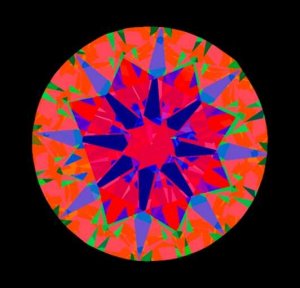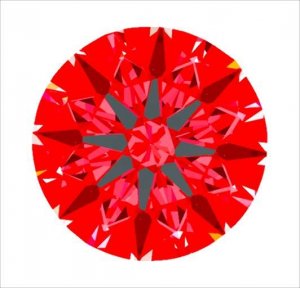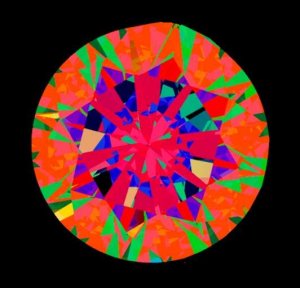- Joined
- Jan 7, 2009
- Messages
- 9,725
HI everyone!
The purpose of this discussion is not to "settle" anything- rather to discuss the methodology of buying a diamond- both in person, and online.
Reflector technology works, and it''s here to stay.
We can agree on that.
My point, is that the use of reflector technology has created an interesting situation. Although undeniably effective, there''s an element to diamond buying that is lost in their use.
The tremendous appeal of this technology is that it "levels the playing field" for the consumer.
It works incredibly well, as evidenced by the huge number of satisfied buyers here on PS. The efficacy is well documented here.
In terms numbers as a whole, reflector technology plays a role in very small percentage of diamond purchases overall.
Lack of use of IS ASET does not, in iteslf, indicate a lack of dedication to great make in diamonds.
Let''s eliminate the mall- and chain stores selling commercial, sometimes poorly made goods.
We still have Tiffany''s Cartier and the "big boys" who do not use reflector technology. We still have Blue Nile, the number one internet diamond seller.
GIA does not use reflector technology.
Would we all be better served if everyone used it?
Isn''t absolutely essential in an internet situation?
As I said above- I don''t think we''ll ever "settle" this one. But since it''s really been something that , from a diamond lover''s standpoint- is really important to me, I appreciate the opportunity to discuss it.
60/60 and the rise of the near tolk
To my recollection, Lazaare Kaplan was the company that successfully coined the phrase "Ideal Cut" - sometime in the ''80''s.
The art of diamond cutting was not nearly as widespread back then as it is today.
By and large, I see less seriously "off make" diamonds coming out of India, for example, as compared to 20 years ago. Of course there are still badly cut diamonds around, but due to advances in technology, the general level of cutting has improved, to a degree. A lot of the Indian good I''ve seen over the past few years have been, at least ostensibly, cut to near tolk proportions.
One aspect that has not changed is that you need to maintain a balance of yield and beauty to be profitable in the diamond cutting business.
When I started to work in diamonds, 60/60, as a target depth table combination made a lot of sense, to a lot of people. The 60% table opens up the heart of the diamond- really allowing a lot of light. The larger table can make the diamond look larger, in many cases.
In fairness to the whole topic, my own personal preferences were surely shaped leaning diamonds in the late ''70''s when 60/60 was the number to hit. To this day, I prefer a slightly "spreadier" stone, such as a 60/60 in a round diamond.
When I started seeing the LK Ideal Cut Diamonds, the table just seemed a little ......squeezed.
Not to say they were not extremely beautiful face up- or set in rings. Just that after looking at 60% tables- and being trained at a company that produced extremely consistent , well cut 60% tabled diamonds, they looked ...different.
There''s no debate which type of cutting design does better using reflector technology.
My point is that, in some instances, something gets lost in this equation.
Is the diamond that does better on the reflector tests the better diamond?
To illustrate what I''m talking about, I got two diamonds. This is by no means a "study" - but it does illustrate the debate clearly.
Here''s what I did.
The other day I looked thru some 1/2carat stones with AGS and GIA reports.
I picked one that is an AGS0. and one that is a 60 tabled stone.
It''s a little deep at 61, but it works for this discussion because using my naked eye, this is the diamond I would pick.
I love BOTH the diamonds that I used- just love the GIA stone a little more.
Round Brilliant Diamond, Loose
WEIGHT: 0.52ct
SHAPE: Round Brilliant
COLOR: E
CLARITY: VS2
MEASUREMENTS: 5.27 - 5.21 x 3.17 mm
TOTAL DEPTH: 60.5%
TABLE SIZE: 56.3%
POLISH: ID
SYMMETRY: ID
FLUORESCENCE: NONE
The second stone has an older GIA report- from before the cut grade.
Round Brilliant Diamond, Loose
WEIGHT: 0.54ct
SHAPE: Round Brilliant
COLOR: E
CLARITY: VVS2
MEASUREMENTS: 5.25 - 5.24 x 3.20 mm
TOTAL DEPTH: 61.0%
TABLE SIZE: 60%
POLISH: EX
SYMMETRY: VG
FLUORESCENCE: NONE
I''ve got my own images, as well as the ASET/IS images, so graciously provieded by Dave Atlas

Thank you for anyone who wishes to participate.
I''ll post images tomorrow.....
The purpose of this discussion is not to "settle" anything- rather to discuss the methodology of buying a diamond- both in person, and online.
Reflector technology works, and it''s here to stay.
We can agree on that.
My point, is that the use of reflector technology has created an interesting situation. Although undeniably effective, there''s an element to diamond buying that is lost in their use.
The tremendous appeal of this technology is that it "levels the playing field" for the consumer.
It works incredibly well, as evidenced by the huge number of satisfied buyers here on PS. The efficacy is well documented here.
In terms numbers as a whole, reflector technology plays a role in very small percentage of diamond purchases overall.
Lack of use of IS ASET does not, in iteslf, indicate a lack of dedication to great make in diamonds.
Let''s eliminate the mall- and chain stores selling commercial, sometimes poorly made goods.
We still have Tiffany''s Cartier and the "big boys" who do not use reflector technology. We still have Blue Nile, the number one internet diamond seller.
GIA does not use reflector technology.
Would we all be better served if everyone used it?
Isn''t absolutely essential in an internet situation?
As I said above- I don''t think we''ll ever "settle" this one. But since it''s really been something that , from a diamond lover''s standpoint- is really important to me, I appreciate the opportunity to discuss it.
60/60 and the rise of the near tolk
To my recollection, Lazaare Kaplan was the company that successfully coined the phrase "Ideal Cut" - sometime in the ''80''s.
The art of diamond cutting was not nearly as widespread back then as it is today.
By and large, I see less seriously "off make" diamonds coming out of India, for example, as compared to 20 years ago. Of course there are still badly cut diamonds around, but due to advances in technology, the general level of cutting has improved, to a degree. A lot of the Indian good I''ve seen over the past few years have been, at least ostensibly, cut to near tolk proportions.
But even though there was far less technology available to cutters, there were some really well cut diamonds around in the years after WWII.
One aspect that has not changed is that you need to maintain a balance of yield and beauty to be profitable in the diamond cutting business.
When I started to work in diamonds, 60/60, as a target depth table combination made a lot of sense, to a lot of people. The 60% table opens up the heart of the diamond- really allowing a lot of light. The larger table can make the diamond look larger, in many cases.
In fairness to the whole topic, my own personal preferences were surely shaped leaning diamonds in the late ''70''s when 60/60 was the number to hit. To this day, I prefer a slightly "spreadier" stone, such as a 60/60 in a round diamond.
When I started seeing the LK Ideal Cut Diamonds, the table just seemed a little ......squeezed.
Not to say they were not extremely beautiful face up- or set in rings. Just that after looking at 60% tables- and being trained at a company that produced extremely consistent , well cut 60% tabled diamonds, they looked ...different.
There''s no debate which type of cutting design does better using reflector technology.
My point is that, in some instances, something gets lost in this equation.
Is the diamond that does better on the reflector tests the better diamond?
To illustrate what I''m talking about, I got two diamonds. This is by no means a "study" - but it does illustrate the debate clearly.
Here''s what I did.
The other day I looked thru some 1/2carat stones with AGS and GIA reports.
I picked one that is an AGS0. and one that is a 60 tabled stone.
It''s a little deep at 61, but it works for this discussion because using my naked eye, this is the diamond I would pick.
I love BOTH the diamonds that I used- just love the GIA stone a little more.
Round Brilliant Diamond, Loose
WEIGHT: 0.52ct
SHAPE: Round Brilliant
COLOR: E
CLARITY: VS2
MEASUREMENTS: 5.27 - 5.21 x 3.17 mm
TOTAL DEPTH: 60.5%
TABLE SIZE: 56.3%
POLISH: ID
SYMMETRY: ID
FLUORESCENCE: NONE
The second stone has an older GIA report- from before the cut grade.
Round Brilliant Diamond, Loose
WEIGHT: 0.54ct
SHAPE: Round Brilliant
COLOR: E
CLARITY: VVS2
MEASUREMENTS: 5.25 - 5.24 x 3.20 mm
TOTAL DEPTH: 61.0%
TABLE SIZE: 60%
POLISH: EX
SYMMETRY: VG
FLUORESCENCE: NONE
I''ve got my own images, as well as the ASET/IS images, so graciously provieded by Dave Atlas

Thank you for anyone who wishes to participate.
I''ll post images tomorrow.....














300x240.png)